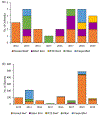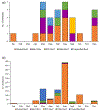Salmonella Outbreaks Linked to Beef, United States, 2012-2019
- PMID: 37028195
- PMCID: PMC10966622
- DOI: 10.1016/j.jfp.2023.100071
Salmonella Outbreaks Linked to Beef, United States, 2012-2019
Abstract
The Centers for Disease Control and Prevention (CDC) has identified nontyphoidal Salmonella as one of the top five pathogens contributing to foodborne illnesses in the United States. Beef continues to be a common source of Salmonella outbreaks, despite the implementation of interventions at slaughter and processing facilities to reduce contamination of beef. We described Salmonella outbreaks linked to beef in the United States during 2012-2019, examined trends, and identified potential targets for intervention and prevention strategies. We queried CDC's Foodborne Disease Outbreak Surveillance System (FDOSS) for all foodborne nontyphoidal Salmonella outbreaks linked to beef as the single contaminated ingredient or implicated food, with the date of first illness onset from 2012 to 2019. Information on antimicrobial resistance (AR) for outbreak-related isolates was obtained from CDC's National Antimicrobial Resistance Monitoring System (NARMS). We calculated the number of outbreaks, outbreak-related illnesses, hospitalizations, and deaths overall, by beef processing category and Salmonella serotype. During 2012-2019, 27 Salmonella outbreaks were linked to beef consumption, resulting in 1103 illnesses, 254 hospitalizations, and two deaths. The most common category of beef implicated was nonintact raw, ground beef (12 outbreaks, 44%), followed by intact raw (six outbreaks, 22%). Ground beef was responsible for the most illnesses (800, 73%), both of the reported deaths, and was the source of the largest outbreak. AR data were available for 717 isolates from 25 (93%) outbreaks. Nine (36%) of these outbreaks had isolates resistant to one or more of the antibiotics tested by NARMS, of which eight (89%) contained multidrug-resistant isolates. Several outbreaks reported highlight challenges faced during investigations, areas where further research may be warranted, and opportunities to prevent future outbreaks along the farm-to-fork continuum.
Keywords: Antimicrobial-resistance; Beef; Ground beef; Outbreaks; Prevention; Salmonella.
Copyright © 2023 The Author(s). Published by Elsevier Inc. All rights reserved.
Conflict of interest statement
Declaration of Competing Interest The authors declare that they have no known competing financial interests or personal relationships that could have appeared to influence the work reported in this paper.
Figures




References
-
- Arthur TM, Brichta-Harhay DM, Bosilevac JM, Guerini MN, Kalchayanand N, Wells JE, Shackelford SD, Wheeler TL, & Koohmaraie M (2008). Prevalence and characterization of Salmonella in bovine lymph nodes potentially destined for use in ground beef. Journal of Food Protection, 71, 1685–1688. - PubMed
-
- Beshearse E, Bruce BB, Nane GF, Cooke RM, Aspinall W, Hald T, Crim SM, Griffin PM, Fullerton KE, Collier SA, Benedict KM, Beach MJ, Hall AJ, & Havelaar AH (2021). Attribution of Illnesses Transmitted by Food and Water to Comprehensive Transmission Pathways Using Structured Expert Judgment, United States. Emerging Infectious Diseases, 27, 182–195. - PMC - PubMed
-
- Collier SA, Deng L, Adam EA, Benedict KM, Beshearse EM, Blackstock AJ, Bruce BB, Derado G, Edens C, Fullerton KE, Gargano JW, Geissler AL, Hall AJ, Havelaar AH, Hill VR, Hoekstra RM, Reddy SC, Scallan E, Stokes EK, Yoder JS, & Beach MJ (2021). Estimate of Burden and Direct Healthcare Cost of Infectious Waterborne Disease in the United States. Emerging Infectious Diseases, 27, 140–149. - PMC - PubMed
-
- Committee on Infectious Diseases, A. A. o. P., Kimberlin DW, Barnett ED, Lynfield R, & Sawyer MH (2021). Red Book: 2021–2024 Report of the Committee on Infectious Diseases. American Academy of Pediatrics.
MeSH terms
Substances
Grants and funding
LinkOut - more resources
Full Text Sources
Medical
Research Materials

